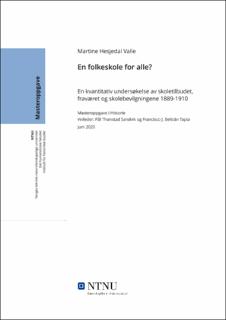| dc.contributor.advisor | Sandvik, Pål Thonstad | |
| dc.contributor.advisor | Tapia, Francisco J. Beltrán | |
| dc.contributor.author | Valle, Martine Hesjedal | |
| dc.date.accessioned | 2021-09-13T16:05:06Z | |
| dc.date.available | 2021-09-13T16:05:06Z | |
| dc.date.issued | 2020 | |
| dc.identifier | no.ntnu:inspera:59158742:21533247 | |
| dc.identifier.uri | https://hdl.handle.net/11250/2775589 | |
| dc.description.abstract | Denne oppgaven er en kvantitativ undersøkelse av folkeskolevesenet i perioden fra to nye skolelover ble innført i 1889 og frem til 1910. De nye skolelovene – en for skolene i kjøbstedene og en for skolene på landet – satte strengere krav til folkeskolene på flere områder. Undervisningstiden skulle utvides, flere fag skulle inn i undervisningen, omgangsskolene skulle avvikles og det ble satt høyere krav til lærerne. Samtidig ble det lokale selvstyret av folkeskolene styrket, og kirkens dominans over skolevesenet betydelig svekket. Ved de nye lovene fikk skolene det nye navnet Folkeskole. Dette representerte Venstres ambisjon om en skole som skulle være felles og lik for alle, uansett samfunnslag. Skolen ble mer lik for alle i tiden etter de nye lovene da skolelovene hadde en effekt på skoletilbudet, men det var fortsatt en lang vei å gå til et likt skoletilbud. I oppgaven benytter jeg skolestatistikk fra Norges Offisielle Statistikk for å undersøke viktige deler av folkeskolevesenet i årene 1891, 1900 og 1910. Temaene som undersøkes er skoletilbudet, elevenes fravær og skolebevilgningene. Oppgavens problemstilling er tredelt. (1) Jeg undersøker hvordan skoletilbudet, elevenes fravær og skolebevilgningene utviklet seg fra 1891 til 1910. Funnene viser at skoletilbudet, i form av undervisningstid, klassestørrelser og antall lærere ble forbedret i perioden, samtidig sank fraværet både i byskolene og landsskolene. Skolebevilgningene økte også fra 1891 til 1910, både kommunenes egne utgifter og statsstøtten. Utgiftene til lønninger var den største posten. (2) Det undersøkes hvilke forskjeller det var i skoletilbudet, fraværet og skolebevilgningene. Det var et tydelig skille mellom by- og landsskolene; byskolene hadde betydelig lengre undervisningstid og flere lærere, det ugyldige fraværet var lavere i byene og skolebevilgningene var høyere. Samtidig undersøker jeg om det var forskjeller i skolevesenet i landkommunene. Funnene viser tydelig at både når det gjaldt undervisningstid, klassestørrelse, antall lærere, fravær og skolebevilgninger var det forskjeller mellom kommunene. Det var noen tydelige geografiske mønstre blant annet på amtsnivå. (3) Til slutt undersøkes noen årsaker til disse forskjellene. Jeg benytter regresjonsanalyse for å se om det var noen sammenheng mellom undervisningstid, fravær og pengebruk, og kommunes næringsstruktur og geografiske forhold. Ved hjelp av regresjonsanalyse forklares noe av variasjonen. Næringsstruktur hadde en effekt på variasjonen, men kanskje mer viktig, for landkommunene, var andre geografiske forhold som påvirket undervisningstiden, fraværet og pengebruken. Dette var blant annet kommunenes størrelse, tilgang til kystlinje og elevenes avstand til skolene. | |
| dc.description.abstract | This master thesis is a quantitative study of the primary schools ‘folkeskolene’ for the period between two new school laws were introduced in 1889 and up to 1910. The new school laws, one for the schools in the urban municipalities and one for the rural municipalities, implemented stricter requirements for folkeskolene in several ways. The amount of school days was extended, more subjects were to be included, the ambulatory schools should be concluded, and higher demands were placed on the teachers. At the same time, the local municipal management of the schools were strengthened, and the church’s dominance weakened. With the new laws the schools were given the name folkeskole. This represented the party Venstre’s program for a school that should be common and equal for everyone, regardless of social status. Despite this, the schools were not equal for everyone. In this thesis I m using school statistics from Norges Officielle Statistikk to examine important parts of the Folkeskole system in the years 1891, 1900 and 1910. The themes that are studied are the provision of education, the school absence and the school funds. I investigate three main things. (1) How the provision of education, absence and school expenditure developed from 1891 to 1910. The findings shows that the provision of education, in terms of school days, class sizes and number of teachers, improved during the period, and at the same time the absence decreased both in the urban and rural schools. School expenditures also increased from 1891 to 1910, both the municipalities own expenses and the state aid. The expenses to wages were the largest expenditure. (2) What differences there were in the school provision, absence and school expenditures. There was a clear distinction between the urban and rural areas: the urban schools had a significantly higher number of school days, more teachers, and the unauthorized absence were lower than in the rural municipalities. School expenditure were also higher in the urban areas. There were some clear geographical patterns at the rural level. (3) Finally, some of the causes for these differences are investigated. I use regression analysis to see if there was any correlation between the number of school days, absence and spending, and the employment structure of the municipalities and geographical conditions. The regression analysis manages to explain some of the variation. The employment structure did have an affect on the variation, but perhaps more important, for the rural municipalities, were other geographical conditions that affected the variation. These were conditions like the municipalities size, coastal areas and the student’s distance to the schools. | |
| dc.language | | |
| dc.publisher | NTNU | |
| dc.title | En folkeskole for alle?
En kvantitativ undersøkelse av skoletilbudet, fraværet og skolebevilgningene 1889-1910 | |
| dc.type | Master thesis | |
